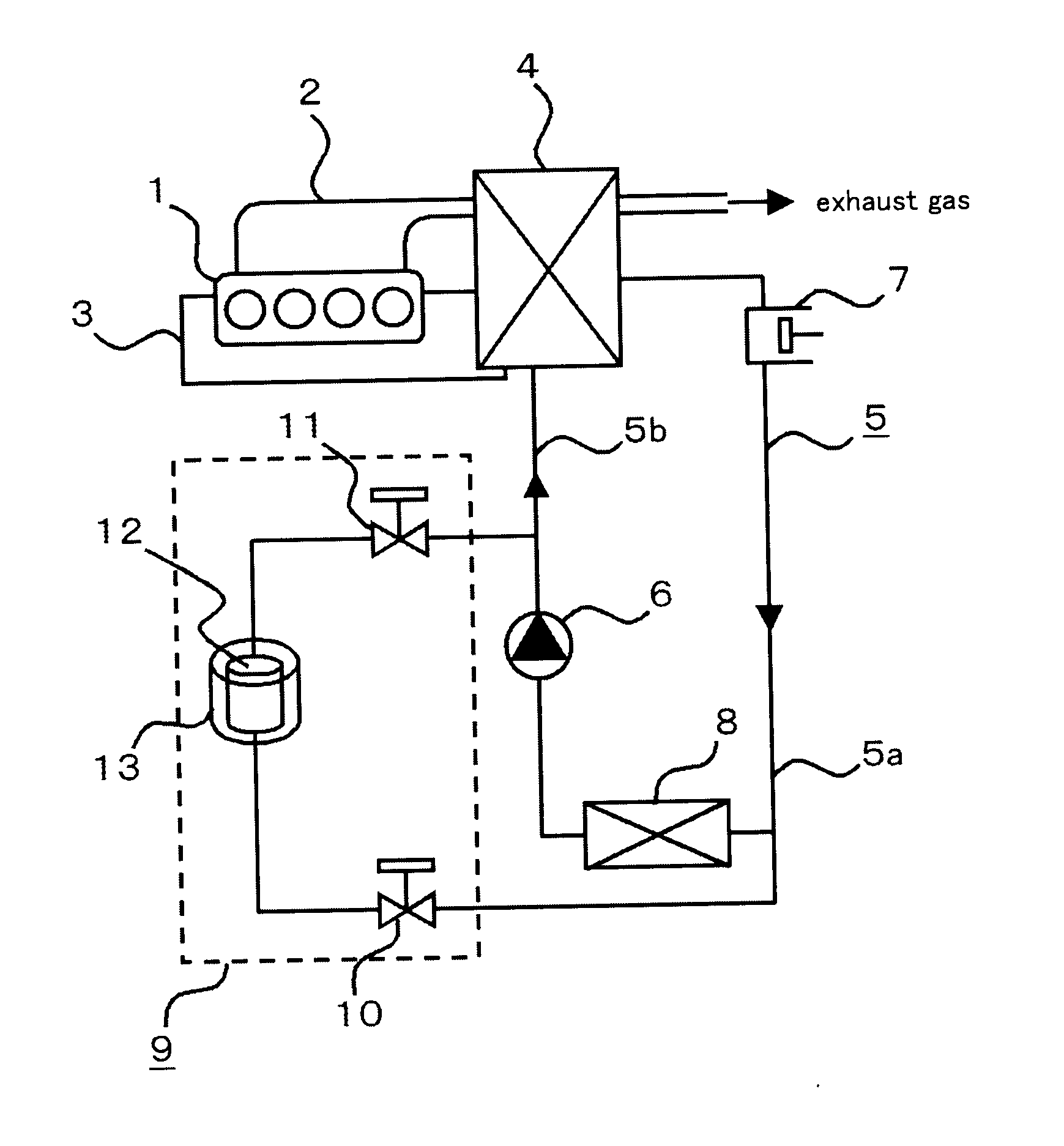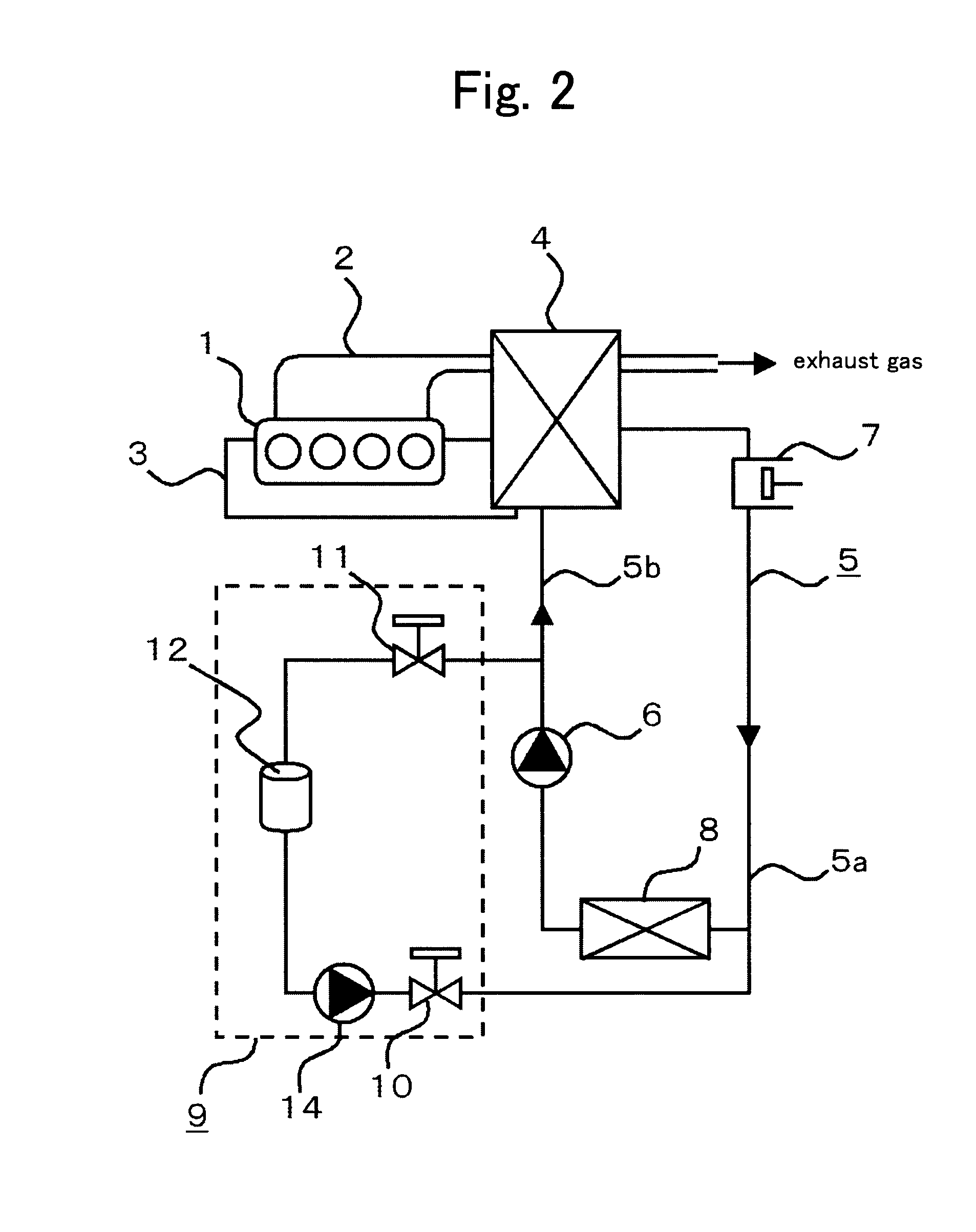Exhaust heat recovery system
a heat recovery system and exhaust heat technology, applied in steam engine plants, combustion engines, machines/engines, etc., can solve the problems of reducing and achieve the effect of optimizing the operation and preventing the reduction of the efficiency of the refrigerant pump
- Summary
- Abstract
- Description
- Claims
- Application Information
AI Technical Summary
Benefits of technology
Problems solved by technology
Method used
Image
Examples
embodiment 1
[0023]FIG. 1 is a configuration view representing an exhaust heat recovery system in Embodiment 1 of the present invention. In Embodiment 1, the exhaust heat recovery system according to the present invention is applied to an engine 1 for an automobile (hereinafter, referred to as an engine 1). The engine 1 is an internal-combustion engine that generates driving force for running. An exhaust pipe 2 exhausts combustion gas (exhaust gas) exhausted from the engine 1 to the atmosphere. In a cooling water circuit 3, engine cooling water is circulated by a cooling water pump (not illustrated).
[0024]A Rankine cycle 5 is configured with a closed circuit in which a cooling-water / exhaust-gas heat exchanger 4, an expander 7, a condenser 8, and a refrigerant pump 6 are sequentially connected. In this closed circuit, a flow route, along a refrigerant-flow direction, from the expander 7 to the refrigerant pump 6 through the condenser 8 is called as a low-pressure circuit portion 5a, while that fr...
embodiment 2
[0038]In Embodiment 1, the temperature adjusting means 13 is used as the refrigerant filling method from the refrigerant tank 12 to the Rankine cycle 5; however, in Embodiment 2, a refrigerant carrying means provided in the refrigerant-filling-amount adjuster 9 is used. FIG. 2 is a configuration view illustrating an exhaust heat recovery system according to Embodiment 2 of the present invention. The refrigerant-filling-amount adjuster 9 according to Embodiment 2 of the present invention is explained referring to FIG. 2. Hereinafter, the system is explained using a refrigerant pump 14 as the refrigerant carrying means.
[0039]In the low-pressure circuit portion 5a, the low-pressure-side valve 10 is connected to the inlet side of the condenser 8 by the pipe. This low-pressure-side valve 10 is closed in a steady state. The low-pressure-side valve 10 is connected by the pipe through the refrigerant pump 14 to a liquid layer portion of the refrigerant inside the refrigerant tank 12.
[0040]W...
embodiment 3
[0045]In Embodiment 3, an operation of the exhaust heat recovery system when the Rankine cycle 5 stops operating is explained. The configuration of the exhaust heat recovery system according to Embodiment 3 is similar to that in Embodiment 1 or Embodiment 2; therefore, its explanation is omitted.
[0046]In the exhaust heat recovery system according to Embodiment 3, when stopping the Rankine cycle 5, by opening the low-pressure-side valve 10, the refrigerant stored in the refrigerant tank 12 is injected into the Rankine cycle 5, and then the system is stopped. Alternatively, after the Rankine cycle 5 has stopped (while the Rankine cycle 5 is suspended), the refrigerant stored in the refrigerant tank 12 is injected into the Rankine cycle 5. Here, the refrigerant filling amount in the Rankine cycle 5 reaches the maximum value, or a value more than a predetermined amount. Here, the predetermined amount is a refrigerant filling amount at which the Rankine cycle 5 can start to operate (that...
PUM
 Login to View More
Login to View More Abstract
Description
Claims
Application Information
 Login to View More
Login to View More - R&D
- Intellectual Property
- Life Sciences
- Materials
- Tech Scout
- Unparalleled Data Quality
- Higher Quality Content
- 60% Fewer Hallucinations
Browse by: Latest US Patents, China's latest patents, Technical Efficacy Thesaurus, Application Domain, Technology Topic, Popular Technical Reports.
© 2025 PatSnap. All rights reserved.Legal|Privacy policy|Modern Slavery Act Transparency Statement|Sitemap|About US| Contact US: help@patsnap.com



